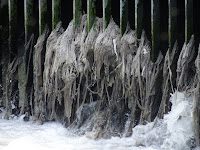Hogsmill Sewage Clean-up
According to blogger stats, one of the most read items of 2016 to date, has been the Hogsmill Sewage Spill (8.2.16). So it follows that it will be the most written about - preferable to answering the many enquiries received - individually. It is a good method of retaining a chronological 'memory' as well as informing ward councillors, who are sufficiently exercised with other sewage related issues, such as the smell.
 |
| Rag at the outfall |
 |
| Operatives from Adler and Allan |
The previous post, detailed the amount of 'rag' that appears downstream of the outfall, virtually every week. But a tremendous amount of this: nappy liners, sanitary towels, condoms and wrappers, cotton wool buds and - although we are told it doesn't survive the HSW outfall - toilet paper ended up on Public Open Space (POS) during a flood 25.6.16.
 |
| Outfall post clean-up |
So here's what happened last Thursday and Friday 30.6.16.....A professional team from Adler and Allan of Tunbridge Wells, came to clean-up the outfall as well as the 'rag and sewage environment' along the Hogsmill as far as Villiers Road.
According to their website: Adler and Allan, began trading as a Coal Merchants in London and after aquisitions of related companies, have become national, undertaking major spill responses and hazardous waste handling for companies and agencies such asThames Water and The Environment Agency.
 |
| Toilet paper (E. Newton) |
 |
| Rag at Ewell Storm Tanks (P Harwood.) |
So why are these spills occurring much more frequently? Data from overflows show that the 'emergency' mechanisms for retaining sewage during times of excess rainfall, are inadequate.
These are known as the storm tanks and they exist further upstream at Ewell Court and at the HSW. The HSW storm tanks overflowed in the river twice during May; 5.5.16 and 30.5.16. What was previously a mechanism for protecting the Hogsmill during extreme events, now serves to deluge the river with a tide of cess, killing fish and creating a hazardous environment for those of us working along and in the river; particularly those engaged on constructing the in-channel river improvements and on the River Fly monitoring projects (see side tabs). The sewage has been overtopping the storm tanks and bypassing the screening processes normally in place to prevent rag entering the stream.
 |
| Cox lane, (M.M. Oates) |
 |
| Misconnection Villiers Road |
In addition, to the misconnections - evidence of sediments, sewage as well as chemical run-off - appearing at every outfall along the Hogsmill, there is also evidence of sewage weiring over the river bank into the Hogmill creating a toxic brew measurable on our basic equipment (and our noses).
 |
| Channel of cess into the Hogsmill |
 |
| Pumping out cess |
On the north-east bank of the Hogsmill on TW land- perpendicular with California Road - there is an old stream, visible on old ordinance survey maps. This has been transformed in a 'channel of cess' with ammonia levels of 3.5% and low levels of dissolved oxygen (5%).
Thames Water have been pumping out the sewage from the channel but it keeps filling up and presumably weiring over into the river.
So why has this situation arisen and what can be done to restore the river quality? The aspirations of the council to develop more and more of our open space see 'Direction of Travel' document will not help this situation. It is also not fair to be expecting our POS's to take more and more these operational impacts (see Fishponds). Kingston’s “Direction of Travel” (on local growth and
development) consultation is available for comment till 29th August at http://consult.kingston.gov.uk/portal/planning/direction_of_travel



Comments
Post a Comment
Please share your thoughts